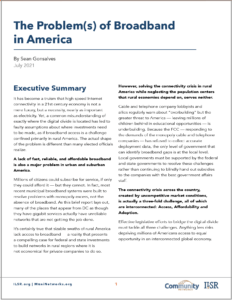 It has become a truism that high speed Internet connectivity in a 21st century economy is not a mere luxury, but a necessity, nearly as important as electricity. Yet, a common misunderstanding of exactly where the digital divide is located has led to faulty assumptions about where investments need to be made, as if broadband access is a challenge confined primarily in rural America. The actual shape of the problem is different than many elected officials realize.
It has become a truism that high speed Internet connectivity in a 21st century economy is not a mere luxury, but a necessity, nearly as important as electricity. Yet, a common misunderstanding of exactly where the digital divide is located has led to faulty assumptions about where investments need to be made, as if broadband access is a challenge confined primarily in rural America. The actual shape of the problem is different than many elected officials realize.
A lack of fast, reliable, and affordable broadband is also a major problem in urban and suburban America.
Millions of citizens could subscribe for service, if only they could afford it — but they cannot. In fact, most recent municipal broadband systems were built to resolve problems with monopoly excess, not the absence of broadband. Many of the places that appear from DC as though they have gigabit services actually have unreliable networks that are not getting the job done.
This policy brief explains that America’s connectivity crisis, created by uncompetitive market conditions, is actually a three-fold challenge: Access, Affordability and Adoption. Federal and state governments must support local governments in resolving these challenges, rather than continuing to blindly hand out subsidies to the companies with the best government affairs staff.
Read The Problem(s) of Broadband in America here.
For timely updates, follow Christopher Mitchell or MuniNetworks on Twitter and sign up to get the Community Broadband weekly update.





